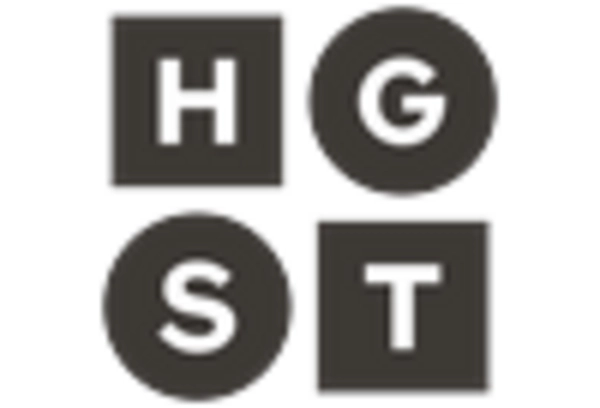The Platter Substrate Material Market is currently characterized by a dynamic competitive landscape, driven by technological advancements and increasing demand for high-performance storage solutions. Key players such as Toshiba (Japan), Seagate Technology (US), and Samsung Electronics (South Korea) are at the forefront, each adopting distinct strategies to enhance their market positioning. Toshiba (Japan) focuses on innovation in material science, aiming to develop substrates that improve data density and reliability. Meanwhile, Seagate Technology (US) emphasizes strategic partnerships to bolster its supply chain resilience, particularly in the face of fluctuating raw material costs. Samsung Electronics (South Korea) is heavily investing in digital transformation initiatives, which include the integration of AI in manufacturing processes to optimize production efficiency and reduce waste. Collectively, these strategies not only enhance individual company performance but also contribute to a more competitive and technologically advanced market environment.
In terms of business tactics, companies are increasingly localizing manufacturing to mitigate supply chain disruptions and optimize logistics. This trend is particularly evident in the Platter Substrate Material Market, which appears to be moderately fragmented, with several key players exerting significant influence. The collective actions of these companies suggest a shift towards a more collaborative approach, where partnerships and alliances are becoming essential for maintaining competitive advantage.
In August 2025, Toshiba (Japan) announced a groundbreaking development in platter substrate technology, unveiling a new material that significantly enhances data storage capacity while reducing energy consumption. This innovation is poised to set a new standard in the industry, potentially reshaping the competitive landscape by compelling other players to accelerate their own R&D efforts. The strategic importance of this move lies in Toshiba's ability to leverage its technological prowess to capture a larger market share, particularly among data-intensive applications.
In September 2025, Seagate Technology (US) entered into a strategic alliance with a leading materials supplier to secure a more stable supply of high-quality substrates. This partnership is expected to enhance Seagate's production capabilities and ensure the availability of critical materials, thereby strengthening its competitive position. The implications of this alliance are profound, as it not only mitigates supply chain risks but also allows Seagate to focus on innovation and product development.
In October 2025, Samsung Electronics (South Korea) launched a new initiative aimed at integrating AI into its manufacturing processes for platter substrates. This move is indicative of a broader trend towards digitalization within the industry, as companies seek to enhance operational efficiency and reduce costs. The strategic significance of this initiative lies in Samsung's commitment to maintaining its leadership position through technological innovation, which is likely to influence competitors to adopt similar approaches.
As of October 2025, the competitive trends in the Platter Substrate Material Market are increasingly defined by digitalization, sustainability, and the integration of AI technologies. Strategic alliances are playing a crucial role in shaping the current landscape, enabling companies to pool resources and expertise to drive innovation. Looking ahead, it is anticipated that competitive differentiation will evolve, with a pronounced shift from price-based competition to a focus on technological advancements, innovation, and supply chain reliability. This evolution underscores the necessity for companies to adapt and innovate continuously to remain relevant in an ever-changing market.

















Leave a Comment